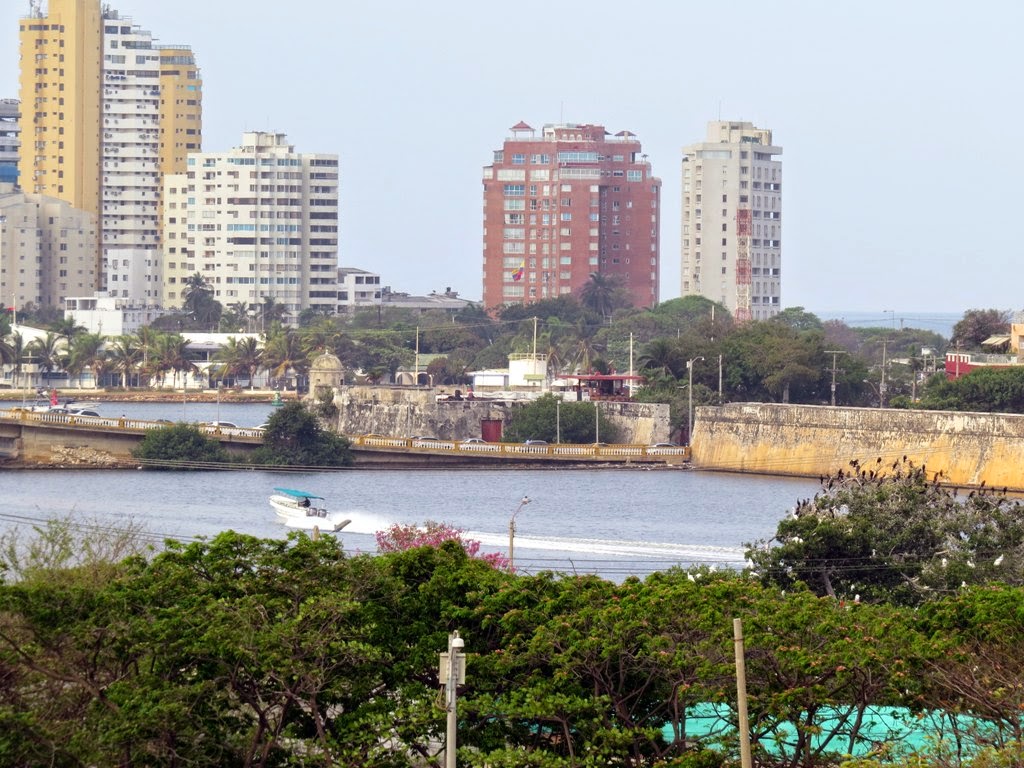Our second stop was in Cartagena. I doubt that if this port was not on a cruise
ship schedule, that we would have ever thought to visit here on our own. We found that the city has a very long,
fascinating and often very violent history.
The first settlers appeared around 4000 BC. The first Europeans arrived in the 1500's. As we entered the harbor, you could begin the
see the mix of the very old and very new city.
Due to the perceived wealth of the area, many
European groups tried to extract that wealth for themselves. The Spanish maintained control of the region
for around 200 years. In order to defend
the city, the castle San Felipe De Barajas Construido was constructed starting
in 1657. The old city still has the
intact outer walls. Our first stop was
the fortress that sits on high ground protecting the city. You cannot help but be impressed with the
sheer size of the structure and the labor that was involved with its
construction.
We arrived in the old city thru one of the numerous
gates. First we walked the narrow
streets and absorbed the old and new culture. There are many sections in the
city that is home to nearly a million people.
Our time was spent mostly in the historic part. The streets and squares show a glimpse of
life in past centuries.
A small church in ill repair house the remains and
history of a Spanish Jesuit priest who arrived in Cartagena in 1610. Soon after his arrival, he began to minister
to the 10, 000 slaves that arrived every year in the port. He devoted his entire life to working among
the slaves. It is estimated that he
baptized over 300,000 people personally.
During his life, authorities tended to see him as a nuisance. However,
after his death, it was realized how admired he was by much of the population,
and he was given a state funeral. His remains are encased within the church altar.
As a colony of the Spanish, Cartagena did not avoid
the Inquisition which raged through Europe. It is generally accepted that the
Spanish version of the Inquisition was
the most severe. We visited the Palace of the Inquisition, which is on the site
where the investigations took place beginning in 1610 and did not completely
end until Cartagena declared independence.
As in Europe, people were targeted because of their beliefs and in some
cases because of the wealth they possessed.
Before leaving, we made a quick stop at one of the
tourist shopping areas in the old city. There is no doubt that these street
vendors are among the most aggressive we have experienced anywhere. We did not
have time to tour the new city, but the bus ride through that area confirmed what we were told about the huge amount and traffic and congestion that could
last for hours.






















































7 comments:
Beautiful colors!! What a violent, long history.. sad... Those Europeans!!
And, I had forgot about that place ... been there, done that too but only because it was a place we stopped when getting ready for an Amazon cruise.. Doubt that we'd ever go back but it certainly was interesting.
What a wonderful history lesson. I have never heard of Cartagena. That poor area. Always fighting someone or someone trying to control it. Thanks for all the great photos.
I had a very strong interest in Cartagena during my career for other reasons... ;c)
Really lovely old city. It seems the Europeans left sadness everywhere in their wake. Great pictures. thanks so much.
I remember people telling us they wouldn't get off the ship in Cartagena ... their loss. I arranged for a private guide to take us on a walking tour, that included the fortress. Loved walking along the top of the city walls. Thanks for taking me back to what I still think of a great port of call.
Thanks for the history lesson and great pictorial tour of Cartegena. Sure are some beautiful old stone buildings - quite the place!
Post a Comment